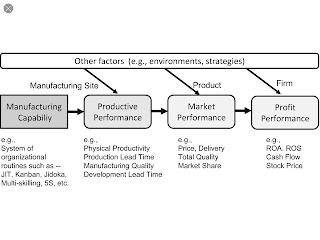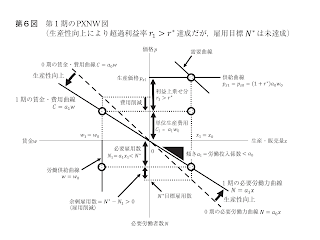藤本隆宏 現場指向企業と製品・工程イノベーション : PXNWモデルによる予備的分析
https://nam-students.blogspot.com/2019/02/the-fractal-keynesian-stimulus-by-csr.html@
参考:
塩沢由典
https://nam-students.blogspot.com/2019/04/blog-post_20.html
Industrial Competitiveness and Design Evolution Editors: Fujimoto, Takahiro, Ikuine, Fumihiko (Eds.)2018
https://www.springer.com/gp/book/9784431551447
https://www.amazon.co.jp/dp/B07G2TRN63/ref=dp-kindle-redirect?_encoding=UTF8&btkr=1
https://nam-students.blogspot.com/2019/02/the-fractal-keynesian-stimulus-by-csr.html@
参考:
塩沢由典
https://nam-students.blogspot.com/2019/04/blog-post_20.html
Industrial Competitiveness and Design Evolution Editors: Fujimoto, Takahiro, Ikuine, Fumihiko (Eds.)2018
https://www.springer.com/gp/book/9784431551447
https://www.amazon.co.jp/dp/B07G2TRN63/ref=dp-kindle-redirect?_encoding=UTF8&btkr=1
財の価格(P),数量(X),賃金(W),雇用数(N),を4軸とする4象限グラフを作成し.これを「PXNWモデル」と呼ぶ.…[Cはコスト]
価格P
l
賃金W-----+------数量X
l
雇用数N
community oriented firm (COF).
現場指向企業
x現場志向型企業
The fractal Keynesian stimulus by CSR — fellows RFIEA
When we think Keynesian recovery, we consider public spending policies. But the COF economic model shows us that the effective creation of demand can also pass through the efforts of companies for their own survival. Consequently, government policies aimed at maintaining employment could include a component promoting the COF approach. Our field studies suggest that there are already many cases of local companies acting as COFs. We need more systematic data collection and statistical analysis, including at the international level, to ensure greater model reliability. Our research already concludes that when there are many community-based enterprises, they contribute to the stability of society, even when government support for socio-economic stability is insufficient. Community-minded enterprises pursue their own full employment policies at their own level.

References:
- Boyer, R., and Y. Saillard, (Ed.), (2002), Régulation Theory. The State of the Art, Routledge, London & New-York.Chamberlin, E.H. (1933) The Theory of Monopolistic Competition: A Re-orientation of the Theory of Value, Harvard University Press.
- Ericsson, C., B. Horgby, and S. Ishihara (2016) Faderliga företagare i Sverige och Japan (Paternalistic employers in Sweden and Japan) , Carlsson.
- Fujimoto, T. (1999). The evolution of a manufacturing system at Toyota. Oxford, UK: Oxford University Press.
- Fujimoto, T. (2014). Innovation management in Japan. Dodgson, M., Gann, D.M. and Phillips, N., eds., The Oxford handbook of innovation management. Oxford, UK: Oxford University Press.
- Fujimoto, T. (2017). Genba-oriented Firms and Product-Process Innovations: A Preliminary Analysis by the “PXNW Model.” (in Japanese). Keizaigaku Ronshu The Society of Economics, The University of Tokyo, 81 (3), 2-19.
- Hall, R. L. and C. J. Hitch. 1939. “Price Theory and Business Behaviour,” Oxford Economic Papers 2: 12–45.
- Hicks, J.R. (1976) “’Revolutions’ in Economics.” In Latsis, ed., Method and Appraisal in Economics. Cambridge, Cambridge University Press. 207-218.
- Keynes, J. M.(1936)The General Theory of Employment, Interest and Money, Palgrave, Macmillan
- Ricardo, D. (1817). Principles of political economy and taxation. G. Bell and Sons.
本稿では,実態としての産業経済,とくに中小中堅企業を含む戦後日本の製造業において多く観察されてきた「現場指向企業」が,現代の標準的な教科書に登場する利益最大化を目指す資本指向企業とは行動パターンを異にしていることに着目し,企業の「現場指向性」(genba-orientedness)を前提とした簡単な古典派経済学的なモデルでその特性を分析してみる.ここで現場とは付加価値を生む場所であり,地域に埋め込まれ,自らの存続と雇用維持を目指す集団的意思を持ったある種の経済主体である.したがって「現場指向企業」の目的は,利益最大化を指向する教科書的企業の場合とは異なり,①企業の一部としての自らの存続(目標マークアップ率の確保)と,②地域の一部としての雇用量の維持の2つとなる.より具体的には,実際に観察される現場指向企業の行動を抽象化する形で,製品市場と労働市場における価格と数量,
すなわち
財の価格(P),数量(X),賃金(W),雇用数(N),を4軸とする4象限グラフを作成し.これを「PXNWモデル」と呼ぶ.
このモデルは,水平の供給曲線(フルコスト原理を伴う古典派経済学的な生産価格),右下がりの需要曲線(製品差異化を前提とした独占的競争),リカード的な労働投入係数を介したリニアな必要労働力曲線,水平の労働供給曲線,および労働投入係数を介したリニアな賃金・費用曲線が仮定される.次にこのモデルを用いて,現場指向企業が,冷戦期の価格安定状況における生産性向上・賃金向上・有効需要創出を経て,利益率と雇用数という2つの目標を同時に満たすある定常状態から別の定常状態に移行できることを示す.次に,冷戦後のグローバル競争による価格低下状況における現場指向企業も,価格低落・生産性向上・有効需要創出を経て,ある定常状態から別の定常状態に移行できることを示す.要するに,現場指向企業が,一定の利益率と雇用数の確保,及び実質賃金の向上を目指すのであれば,工程イノベーション(物的生産性の向上)と製品イノベーション(有効需要の創出)の両方を行うことが必須であることを,この古典派経済学的モデルは示唆している.すなわち,実際の戦後日本の製造企業の典型的な行動パターンをよりよく描写できているのは,教科書的な利益最大化企業のモデルよりはむしろ,一定の利益率と雇用数を同時に追求する「現場指向企業」モデルである可能性を,本稿は示している.
略歴
- 東京都出身[1]
- 東京教育大学附属駒場高等学校卒業
- 1979年東京大学経済学部経済学科卒業
- 1989年ハーバード大学ビジネススクール博士号 (D.B.A.) 取得。
- 株式会社三菱総合研究所勤務
- 1990年東京大学経済学部助教授
- 1999年同大大学院経済学研究科教授。
トヨタ生産方式をはじめとした製造業の生産管理方式の研究で知られる。
著作
単著
- 『生産システムの進化論―トヨタ自動車にみる組織能力と創発プロセス』(有斐閣、1997年)
- 『生産マネジメント入門〈1〉生産システム編』(日本経済新聞社、2001年)
- 『生産マネジメント入門〈2〉生産資源・技術管理編』(日本経済新聞社、2001年)
- 『能力構築競争-日本の自動車産業はなぜ強いのか(中公新書1700)』(中央公論社、2003年)
- 『日本のもの造り哲学』(日本経済新聞社、2004年)
共著
脚注
- ^ 『読売年鑑 2016年版』(読売新聞東京本社、2016年)p.340
























2 Comments:
2
価格安定期
(冷戦下)
における生産性向上と需要創造
2.1
能力構築による生産性上昇
(第1期)
「現場指向企業」の適応行動を見る前にまず,第1期においてはそれとの対比も兼ねて,「資
本主義的企業」が工程イノベーション等によって生産性を向上させるケースを考えてみよう
(第6図)。たとえばスミスの分業体系,マルクスの協業体系, ンユンペータの工程イノベー
ションなどによって物的労働生産性が高まるケースである
PXNw図において,
物的労働生産性の向上
(労働投入係数の低減)
は単純に,
必要労働力
現場指向企業と製品·工程イノベーション_PXNWモデルによる予備的分析
第6図
第1期のPXNW図
(生産性向上により超過利益率η〉r*達成だが,
雇用目標
は未達成)
価格p
需要曲線
0期の賃金·費用曲線C = ao w
生産性向上
生産価格psi
供給曲線
利益上乗せ分
1期の賃金·費用曲線
費用削減
単位生産費用
G = al wo
0
賃金w
生産·販売量
必要雇用数
傾きa!-労働投入係数< ao
労働供給曲線
0
1期の必要労働力曲線
N = a, x
N*目標雇用数
﹀生産性向上
余剰雇用数=N*-N1 > 0
(雇用削減)
0期の必要労働力曲線N
a0%
必要労働者数N
曲線(図の右下) と賃金·費用曲線(左上)が反時計回りに回転すること Cao 〉 a1)で示さ
れる. とりあえず製品市場佑上) も労働市場(左下) も変化が無いならば, この「回転」の
結果,生産費用は低減し (C1 = a1 . wo 〈ao . wo-Co),供給価格が不変なら,図の右上に示
したように利益上乗せ率は高まるが(r1〉r),他方で,図の右下に示したように必要労働力
(N1)は目標雇用量(N*) を下回り,解雇が発生する (N1〈N*)
しかし「資本主義的企業」は「現場指向企業」とは異なり、利益の最大化を目指し,雇用量
維持にはコミットしないので, 当該企業は競争により価格が下がるまで追加利益を獲得し続け
る·マルクスの『資本論」([Marx, 1867])の場合,個別企業でこれが起これば当該企業に「特
別剰余価値1が発生し、産業全体で生産性上昇(社会的生産カの増大)が起これば「相対的剰
ケインジアンの回復を考えるとき、公共支出政策を検討します。 しかし、COFの経済モデルによれば、効果的な需要創出は、企業の存続のために企業の努力を乗り越えることもできるということです。 したがって、雇用維持を目的とした政府の政策には、COFアプローチを促進する要素が含まれる可能性があります。 現地調査によると、地元企業がCOFとして活動しているケースはすでに多数あります。 モデルの信頼性を高めるためには、国際レベルを含め、より体系的なデータ収集と統計分析が必要です。 私たちの研究はすでに、多くの地域密着型企業があるとき、たとえ政府が社会経済的安定性を支持するのが不十分であっても社会の安定性に貢献すると結論しています。 コミュニティ志向の企業は、独自のレベルで独自の完全雇用ポリシーを追求しています。
コメントを投稿
<< Home